Mathematical Treasure: Textbooks of Sylvestre Lacroix
Sylvestre Lacroix (1765-1843) was a French mathematician and Professor of Mathematics in several post-revolutionary French institutions of higher education. He spent much of his career teaching at the École Polytechnique in Paris. Lacroix was a textbook writer of wide scope who incorporated into his works the revolutionary concept that knowledge should be for public consumption. As a result of this innovation, his textbooks were adopted, sometimes after translation, throughout Europe and the early United States of America. See images of these texts at the following webpages:
- Textbooks of Lacroix: Differential and Integral Calculus
- Textbooks of Lacroix: Arithmetic and Descriptive Geometry
- Textbooks of Lacroix: Elements of Algebra and Geometry
- Textbooks of Lacroix: A Text by Lacroix and Bézout in America
Textbooks of Lacroix: Differential and Integral Calculus
Sylvestre Lacroix (1765-1843) was a French mathematician and Professor of Mathematics in several post-revolutionary French institutions of higher education. He spent much of his career teaching at the École Polytechnique in Paris. Lacroix was a textbook writer of wide scope who incorporated into his works the revolutionary concept that knowledge should be for public consumption. As a result of this innovation, his textbooks were adopted and adapted throughout Europe and the early United States of America.
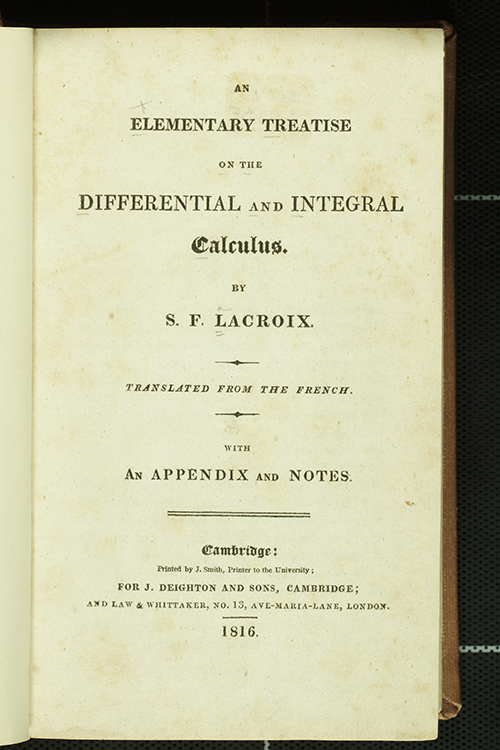
Perhaps Lacroix’s most influential books were the comprehensive calculus text, Traité de calcul differéntial et du calcul intégral (1797-1798), and the calculus text he himself used for teaching, Traité élémentaire de calcul differéntial et du calcul intégral (1802). In 1816, the latter book was translated from French to English by Charles Babbage, George Peacock, and John Herschel at Cambridge University, and adopted for the teaching of calculus there. This action exposed English students of mathematics to the “continental mathematics.” The title page of the English translation of this revolutionary book is shown above.
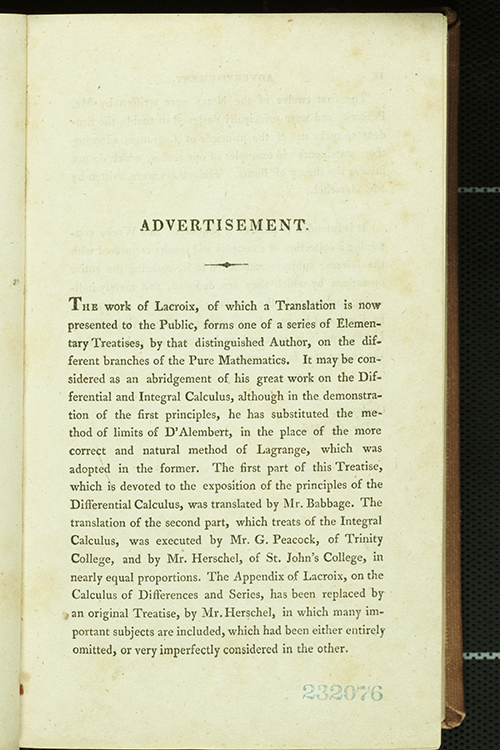
The “Advertisement” on page iii, above, explains the undertaking of the translation.
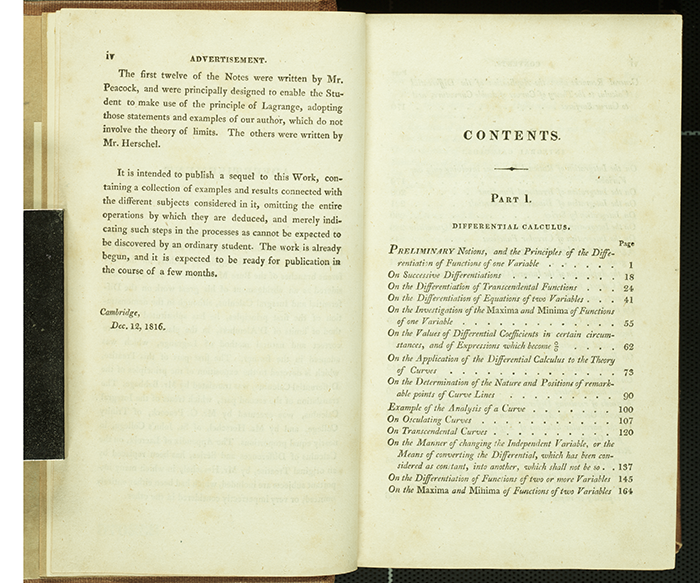
The “Advertisement” continues on page iv and the “Table of Contents” begins on page v.
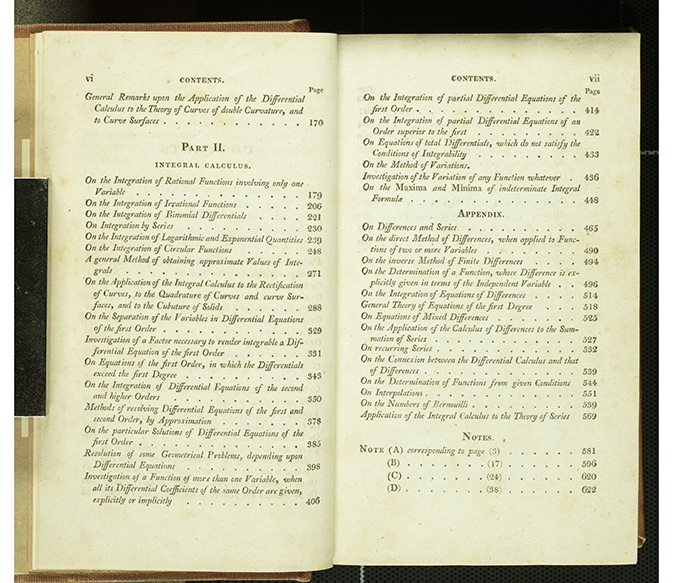
The remainder of the “Table of Contents,” above, reveals the topics of study. Lacroix’s calculus texts were the first mathematics books to introduce the term “analytic geometry.”
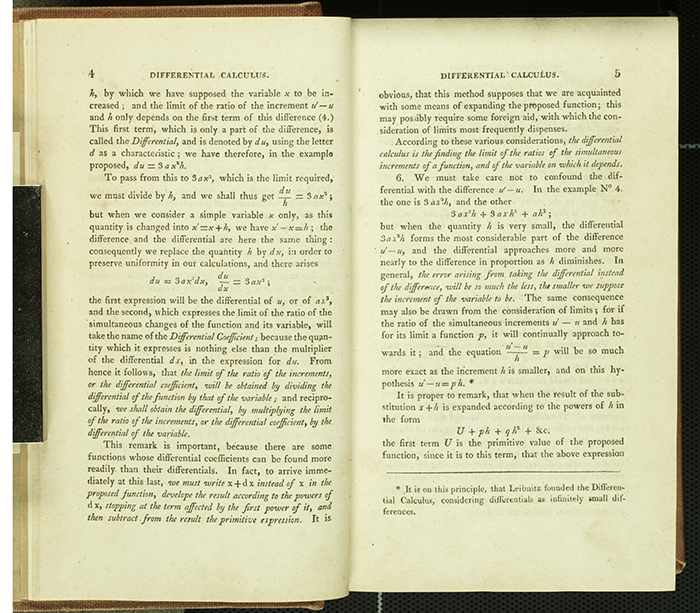
Pages 4 and 5, above, contain an explanation of the differentiation process. The differential of an expression is defined using the example \(f(x)=ax^3\) and \(f^{\prime}(x) =3ax^2.\)
The images above are supplied through the courtesy of the Rare Books and Manuscript Collection of the Pennsylvania State University Library and the assistance of Dr. Sandra Stelts, Curator of the Collection.
Reference
J. J. O’Connor and E. F. Robertson, “Sylvestre François Lacroix (1765-1843),” MacTutor History of Mathematics Archive.
Textbooks of Lacroix: Arithmetic and Descriptive Geometry

This is the title page of Lacroix’s Arithmetic, first published in 1797. The edition shown is the ninth, published in 1810.

The “Library Bird,” Avis du Librarie, announced that the Arithmetic would be the first book in a planned series, “A Course in Elementary Pure Mathematics,” which would also include works on Algebra, Geometry, Trigonometry, Analytic Geometry, Descriptive Geometry, and Calculus. The author’s signature completed the statement. Images from the work on Calculus appeared on the preceding webpage; images from Lacroix's text on Descriptive Geometry can be viewed below and from his texts on Algebra and Geometry on the next webpage.

This is the title page of Lacroix’s Descriptive Geometry, the third edition, published in 1808. Lacroix’s first text on descriptive geometry was published in 1795.

Pages 74 and 75, above, discuss the two projective situations shown in Figures 55 and 56, below, which are, respectively, the intersection of a sphere and a cone and the intersection of two cones.

Here on Plate VII, diagrams for several projective situations are given: in Figure 55, the intersection of a cylinder and a sphere; in Figures 56 and 57, the intersection of two cones; and in Figure 58, the projection of a circle onto an oblique plane.
The images above are supplied through the courtesy of the Rare Books and Manuscript Collection of the Pennsylvania State University Library and the assistance of Dr. Sandra Stelts, Curator of the Collection.
Reference
J. J. O’Connor and E. F. Robertson, “Sylvestre François Lacroix (1765-1843),” MacTutor History of Mathematics Archive.
Textbooks of Lacroix: Elements of Algebra and Geometry

This is the title page of Lacroix’s Elements of Algebra, the ninth edition, 1811. The book was first published in 1800.

On page 13 of his Algebra, above, Lacroix discussed the construction of algebraic statements involving one variable, \(x,\) and three constants, \(a, b, c.\)
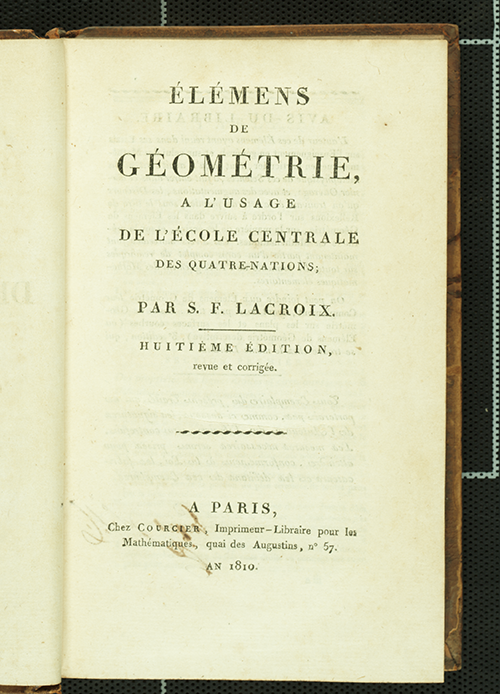
This is the title page of Lacroix’s Elements of Geometry, sixth edition, 1810. The work first appeared in 1799.

On pages 78 and 79 of Lacroix's Geometry, above, Problems 124, 125, and 126 are posed. Each problem requires the construction of a circle under given conditions. A reader of French can appreciate the specific details of the explanations. Problems 124 and 126 can be understood by referring to Figures 70 and 64 in accompanying Plate IV.

Plate IV, above, illustrates various geometric situations involving circles that are considered in the text.
The images above are supplied through the courtesy of the Rare Books and Manuscript Collection of the Pennsylvania State University Library and the assistance of Dr. Sandra Stelts, Curator of the Collection.
Reference
J. J. O’Connor and E. F. Robertson, “Sylvestre François Lacroix (1765-1843),” MacTutor History of Mathematics Archive.
Textbooks of Lacroix: A Text by Lacroix and Bézout in America
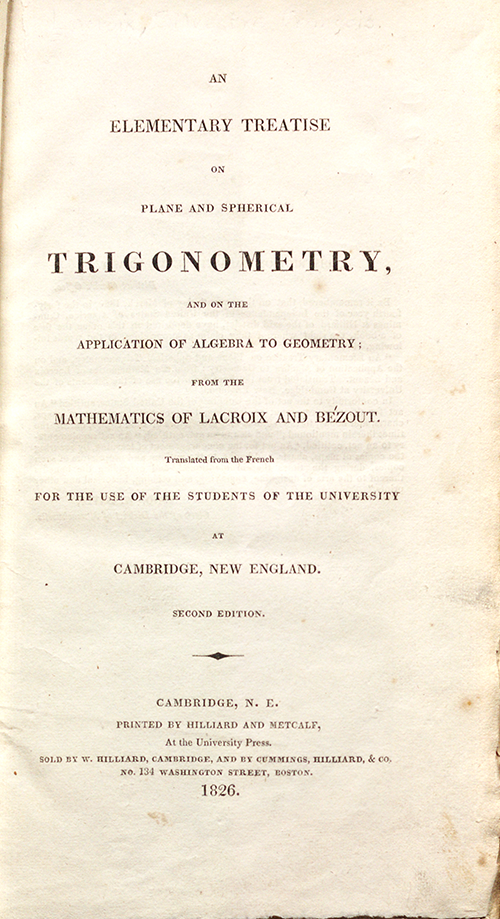
This is the title page of An Elementary Treatise on Plane and Spherical Trigonometry, and on the Application of Algebra to Geometry; from the Mathematics of Lacroix and Bèzout, second edition, 1826. The first edition was published in 1820. It is believed to have been translated from French to English by John Farrar (1779-1853) [1], who was Hollis Professor of Mathematics and Natural Philosophy at Harvard College in Cambridge, Massachusetts, from 1807 to 1836 [2].
Étienne Bézout (1730–1783) was a noted French algebraist. He wrote a six-volume comprehensive work titled Cours complet de mathématiques à l'usage de la marine et de l'artillerie (1770–1782), which was considered accessible to students who wished to enter the École Polytechnique. Bézout’s texts were translated into English and used in both England and America, including at Harvard [3]. As seen in the preceding webpages, Lacroix wrote a similar “course” of elementary texts, considered to be accessible to students of mathematics at a slightly higher level than those of Bézout [4]. In the "Advertisement" below, the translator explained exactly which parts of Lacroix's and Bézout's series of texts he used to form the volume featured on this page.
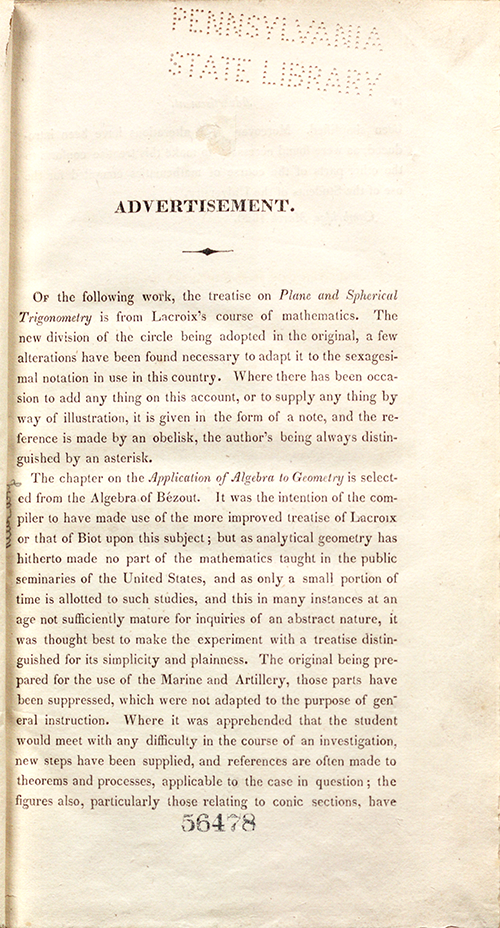

The “Advertisement,” above, serves as a preface and indicates specifically the reliance of the American textbook writer on his French sources.

The “Table of Contents,” above, indicates the topics of study at this time.
The images above are presented courtesy of the State Library of Pennsylvania, in Harrisburg, PA. Dr. Iren Snavely, Curator of Rare Books and Manuscripts, was particularly helpful in securing these images.
References
[1] WorldCat entries for An Elementary Treatise on Plane and Spherical Trigonometry; and the Application of Algebra to Geometry: from the Mathematics of Lacroix and Bèzout, 1820 and 1826.
[2] “John Farrar (1779-1853),” Harvard University Library.
[3] J. J. O’Connor and E. F. Robertson, “Étienne Bézout (1730-1783),” MacTutor History of Mathematics Archive.
[4] J. J. O’Connor and E. F. Robertson, “Sylvestre François Lacroix (1765-1843),” MacTutor History of Mathematics Archive.